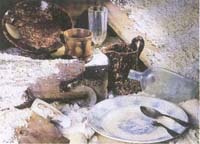The Civil War Underwater
Sarah McDowell with Mark Wilde-Ramsing

Artifacts recovered from the Maple Leaf
Wrecks closer to home in American waters, while often less fiercely debated, are equally as important. Recently Civil War era wrecks like the HL Hunley and the Monitor have attracted public interest. Before these ships became “hot topics,” wrecks like the Maple Leaf proved that their archaeological remnants are crucial to understanding the history of these ships. But what do all of these ships have in common? Why are they so important to archaeologists, social scientists, and the public? What do they say about the past and the Civil War? No document or photograph could replace the value of wrecks such as these. They are time capsules, some still carrying the armament, cargoes, even crew from the day they sank. They were the technological forerunners of the modern navy, and they were the graves of thousands of men.
At these shipwrecks, archaeologists do a different type of archaeology. While they are diving, and not digging, they are still challenging the human mind to think about the past. These sites, though hidden beneath the waves, still have stories to tell. Even sites that appear too damaged, like the Maple Leaf, can offer insight otherwise unfound. The artifacts that are recovered, like those from the Hunley or the technological marvels from the Monitor, all remind us of the human side to the Civil War; great minds making stunning innovations, sailors sacrificing their lives, all stories waiting beneath the waves.
Sarah McDowell is an anthropology major at the University of Delaware.